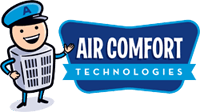Blog
If you are like many other people, when you hear the words “air pollution”, you probably associate it with outdoor smog, auto emissions and industrial smoke. Unfortunately, the truth is the air quality inside homes and offices can actually be more polluted than the outside air. Environmental researchers have found that indoor air is frequently five times more polluted than the air outdoors and in extreme cases, as much as 100 times more contaminated. Your home’s indoor air quality, including the humidity, temperature and the presence of contaminants and allergies can have a significant impact on the health of your family.
What Exactly Is Indoor Air Quality?
Indoor air quality (IAQ) means the condition of your home’s indoor air. The factors of indoor air quality include humidity, temperature, air freshness and air purity. If these conditions are managed appropriately, it may lead to poor indoor air quality. Indoor air that is excessively polluted, humid, stagnant, hot, dry and/or cold can cause a wide range of problems, including discomfort, excessively high energy bills, damage to your home and belongings and serious health problems.
Poor Indoor Air and Your Health
The minute and often times, invisible particles in your home’s air can cause a serious threat to your family’s health. These particles invade your body’s filtering mechanisms and eventually find their way into the lung tissues, while carrying toxic substances that may be absorbed into your body. Breathing in poor indoor air and harmful particles will trigger your body’s natural defense mechanisms, provoking an overactive immune response that causes acute or chronic allergy symptoms. Some of the most common harmful particles found in homes include:
- Dust mites
- Fine dust
- Mold spores
- Pet dander
- Pollen
In many situations, an allergic reaction to these particles is severe; asthma is the most common as well as one of the most serious. Other allergic reactions may be subtle and chronic, with symptoms that include watery eyes, runny nose, recurring headaches, snoring and even lethargy. Unfortunately, many people experience these symptoms without knowing that they are allergy related and that prevention is possible.
The good news is there are ways you can take to prevent contaminants in your home’s air. The first step is to eliminate the contaminants and prevent them from entering your home. By taking the necessary steps to reduce the creation of new contaminants by keeping the windows closed during the days when pollen is high, not smoking indoors and choosing cleaners and building materials carefully. After taking the appropriate steps to control the source of contamination, you can then take aggressive steps to remove the indoor air pollution from your home. For example, there are several varieties of air cleaners that are excellent at removing contaminants, including viruses and bacteria from your indoor air.
Arranging an evaluation of your home’s indoor air quality is the most important step you can take in reducing the risk of polluting your homes indoor air quality. Contact Air Comfort Technologies today to learn more information about how we can help improve your home’s indoor air quality.

